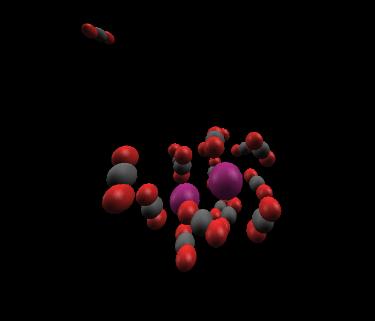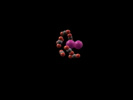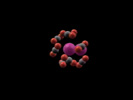
Claudio J. Margulis and David F. Coker
Department of Chemistry
Boston University
We investigate the photodissociation, geminate recombination and relaxation dynamics in size-selected I2¯ · (CO2)n cluster ions using an electronically nonadiabatic molecular dynamics method and a model Hamiltonian gained from diatomics-in-ionic systems (DIIS).
These theoretical studies make contact with recent time resolved pump-probe, and photoelectron detachment experiments. Our studies reveal a rich excited state dynamics in which various competing electronic relaxation channels as well as vibrational relaxation influence the recovery of signal in these experiments.
The first two video segments for the smaller I2¯ · (CO2)8 show how nonadiabatic electronic state changes can lead to switching of the excess charge from an initially externalized charge state of the cluster, to a state in which the excess charge is solvated by the CO2 molecules and the I2¯ dissociates. Recombination can also take place if this charge switching is initially ineffective. The third video sequence shows relaxation in a larger cluster I2¯ · (CO2)16 with a completed first solvation shell. The electronic states of the completely solvated molecule are very different than in the smaller cluster leading to very different relaxation dynamics. These findings are supported by earlier laboratory results.
Video Segments
An iodine molecular ion (I2¯) embedded in a cluster of carbon dioxide molecules (CO2) is excited electronically. We study the transfer of this excitation energy to the CO2 molecule motions in different sized clusters.
Iodine atoms are purple spheres. CO2 molecules are formed from grey carbon atoms and red oxygen atoms.
Video Sequence
Segment 1: I2¯(CO2)8 photo-excitation leading to I2¯ dissociation.
Video Sequence
Segment 2: I2¯(CO2)8 photodissociation followed by recombination and complete evaporation of cluster.
Video Sequence
Segment 2: I2¯(CO2)16 photodissociation and recombination, followed by heating of large cluster. Evaporation is slow due to strong attractions between CO2 molecules.
Hardware: SGI Power Challenge Array and SGI Origin 2000.
Software: Fortran 90. Visualization done using IDL, C, IRIS Performer.
Graphics programming and video production: Erik Brisson and Robert Putnam, Scientific Computing and Visualization Group, Boston University.
Acknowledgments: We gratefully acknowledge financial support for this work from the National Science Foundation (Grant No. CHE-9521793), and a generous allocation of supercomputer time from Boston University’s center for Scientific Computing and Visualization.



